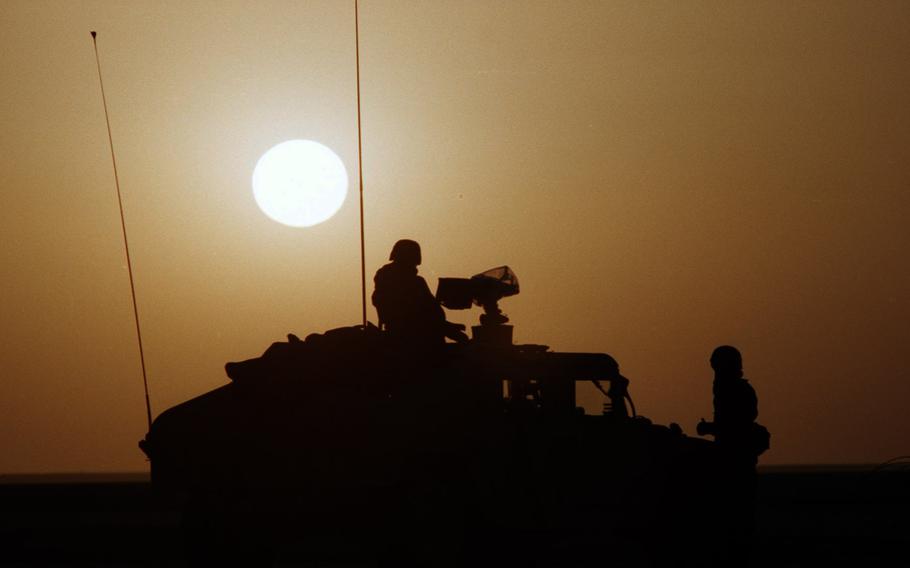
U.S. service members are silhouetted against the desert sun during the Gulf War. (Stars and Stripes)
New research from a Texas doctor has linked the onset of Gulf War illness in some veterans to exposure to the deadly nerve gas sarin.
“Our findings prove that Gulf War illness was caused by sarin, which was released when we bombed Iraqi chemical weapons storage and production facilities,” said Dr. Robert Haley, professor of internal medicine and director of the Division of Epidemiology at the University of Texas Southwestern Medical Center. “There are still more than 100,000 Gulf War veterans who are not getting help for this illness and our hope is that these findings will accelerate the search for better treatment.”
Haley, a medical epidemiologist who studies disease outbreaks in groups of people, has been investigating Gulf War illness for 28 years and used a genetic study that found some people have a stronger natural ability to fight the deadly chemical.
Troops who have genes that help metabolize the gas were less likely to develop the myriad of symptoms associated with the mysterious illness than those without it, according to the new research, which was released Wednesday. The findings were published in Environmental Health Perspectives, a peer-reviewed medical journal.
Following the Gulf War, which ended in 1991, returning veterans began reporting a wide range of chronic symptoms, including fatigue, fever, night sweats, memory and concentration problems, difficulty finding words, diarrhea, sexual dysfunction and body pain. Since then, academic researchers and the Department of Veterans Affairs have been looking for the cause within the many toxic exposures that veterans faced such as burning oil wells, pesticides, nerve gas and anti-nerve gas medication, and depleted uranium.
About 250,000 veterans are affected by Gulf War illness, yet no cause has been widely accepted, according to the medical journal.
Sarin, which the military has confirmed as present during the war, is a toxic, synthetic nerve agent that was first developed as a pesticide. It has been used in chemical warfare and its production was banned in 1997.
When people are exposed to either the liquid or gas form, sarin enters the body through the skin or airways and attacks the nervous system. High-levels of exposure often results in death, but studies of survivors have revealed that lower-level sarin exposure can lead to long-term impairment of brain function, according to the Texas university’s research.
What causes the variety of symptoms in veterans is the sarin exposure triggering inflammation in the brain, called chronic neuroinflammatory condition, Haley said. Knowing that, he would like to see other studies build on his research to develop treatments and cures.
“This is actually a very optimistic finding, because it’s not brain damage,” he said. “There’s nothing you can do about that.”
Haley said he first began his research on Gulf War illness at the urging of Texas billionaire and Navy veteran Ross Perot, who funded Haley’s initial study in the early 1990s.
Even at the time, one of the strongest risk factors for those who were sick related to being in locations with increased possibility for nerve gas exposure, Haley said. The research contradicted the government’s conclusion of the time, which was the illness was caused by stress, he said.
“That set off a firestorm,” Haley said. “We were besieged for two or three weeks. Our phones didn’t stop ringing. It was incredible. Then we got some funding from the Defense Department.”
The latest research from Haley and his colleagues studied 508 veterans who deployed and contracted Gulf War illness and 508 veterans who deployed but did not develop any symptoms. They gauged sarin exposure by asking whether the veterans had heard chemical nerve gas alarms sound during their deployment and by collecting blood and DNA samples from each person.
The researchers tested the samples for variants of a gene called PON1. There are two versions of PON1: the Q variant generates a blood enzyme that efficiently breaks down sarin while the R variant helps the body break down other chemicals but is not efficient at destroying sarin. Everyone carries two copies of PON1, giving them either a QQ, RR or QR genotype.
“Your risk is going up step by step depending on your genotype, because those genes are mediating how well your body inactivates sarin,” Haley said. “It doesn’t mean you can’t get Gulf War illness if you have the QQ genotype, because even the highest-level genetic protection can be overwhelmed by higher intensity exposure.”
The research doesn’t rule out that other chemical exposures could be responsible for a small number of cases of Gulf War illness. However, Haley’s team carried out additional genetic analyses on the new data, testing other factors that could be related, and found no other contributing causes.
The VA presumes disability for veterans with certain chronic, unexplained symptoms existing for six months or more are related to Gulf War service without regard to cause, including chronic fatigue syndrome, fibromyalgia and some gastrointestinal disorders, according to the department. Those veterans might also be eligible for other benefits including a health exam, health care and disability compensation.
Since the study was published, Haley said he’s already received letters from two veterans asking if getting tested for the different forms of the PON1 gene and blood enzyme levels would be helpful. The test isn’t clinically available yet, but should be soon, Haley said. Then there could be some value to getting tested, but it’s more important now to seek treatment for any symptoms that they are experiencing, he said.